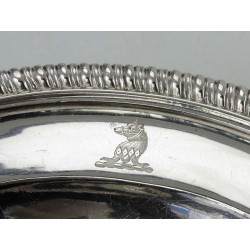Elkington Centrepiece & Plateau, 1865














£7,995.00
Table Centrepiece & Plateau - Graeco-Pompeian Style; Parcel Gilt - Birmingham 1865/75 by Elkington & Company - 50cm overall height; 28cm diam. of glass bowl; 32.5cm max. width of plateau; 2290g weighable silver; 6100g overall weight - Ref. No.: GH/1071
This majestic silver centrepiece in the 'Graeco-Pompeian' style just oozes high quality. It was originally designed for Elkington & Co. by Albert Willms for the International Exhibition of 1862 (see below for more information). Elkington & Company were the premier makers of large centrepieces during Queen Victoria's reign. Please note that this is a fully hallmarked silver piece - the vast majority of centrepieces to be found are in silver plate.
The main centrepiece is decorated with anthemion engraving to the round foot and rises up on three sinuous supports to the vase-shaped dish holder at the top. It stands on three lion's paw feet and has anthemion pendants hanging from the upper section. The whole is very tastefully parcel gilt with the highlights showing up in gold.
The round glass dish appears to be original and sits securely to the dish ring at the top. This clear dish has a serrated rim above a central band of cut diamonds with ruby red hexagonal centres.
The mirror plateau is a bonus adding to the height and increasing the statement made by this beautiful centrepiece. The plateau was added 10 years after the original stand and is a trefoil shape with parcel-gilt decoration to match. It has a mahogany insert with three hallmarked silver feet and as such is not included in the weighable silver (it weighs 2720 grams gross). There are a couple of very small imperfections to the silvering of the glass (see close-up photo), but they have no effect on the overall appeal of this magnificent centrepiece.
Centrepieces such as this are ideal for standing on a dining room table and the glass dish filled with fruit. The very top section has a circular hole just under the top to allow a cable to run through the thread in the middle of the dish ring and so if preferred one could use it as a lamp standard instead. The centrepiece and plateau can also be used independently of each other.
The main centrepiece is fully hallmarked for Birmingham 1865 to one of the feet and appropriately part marked on the struts and dish ring. There is a registration design kite to the underside showing that the design was patented on the 3rd May 1862. The plateau is also fully hallmarked for Birmingham 1875 by Frederick Elkington.
Following an already illustrious career working with some of the most highly regarded firms of the day, Albert Willms was hired by Elkington & Co. to create a service for the Duke of Brabant and then from 1857 to direct the company's designs. The designer had already worked with Jean-Valentin Morel on pieces for the Great Exhibition of 1851 and with Chrisofle and Paillard for the Paris Exposition of 1855; and so would have been an obvious choice for Elkington when designing for the Exhibition of 1862. He won a medal at the International Exhibition for his works, and there is no doubt that this creation for Elkington; which was very highly praised at the time, was a significant contributor to the designer's success of that year.
A table garniture in electroplate from the full Graeco-Pompeian service was sold at Sotheby's, London, The Great Exhibitions Sale, 31 October 2006, lot 537 for £48,000. http://www.sothebys.com/en/auctions/ecatalogue/2006/the-great-exhibitions-sale-l06735/lot.537.html
The International Exhibition or Great London Exposition was a World fair held in South Kensington, London from May 1st to November 1st 1862. It featured 28,000 exhibitors from 36 different countries and attracted over 6 million visitors.
An important and fabulous piece in superb condition.




